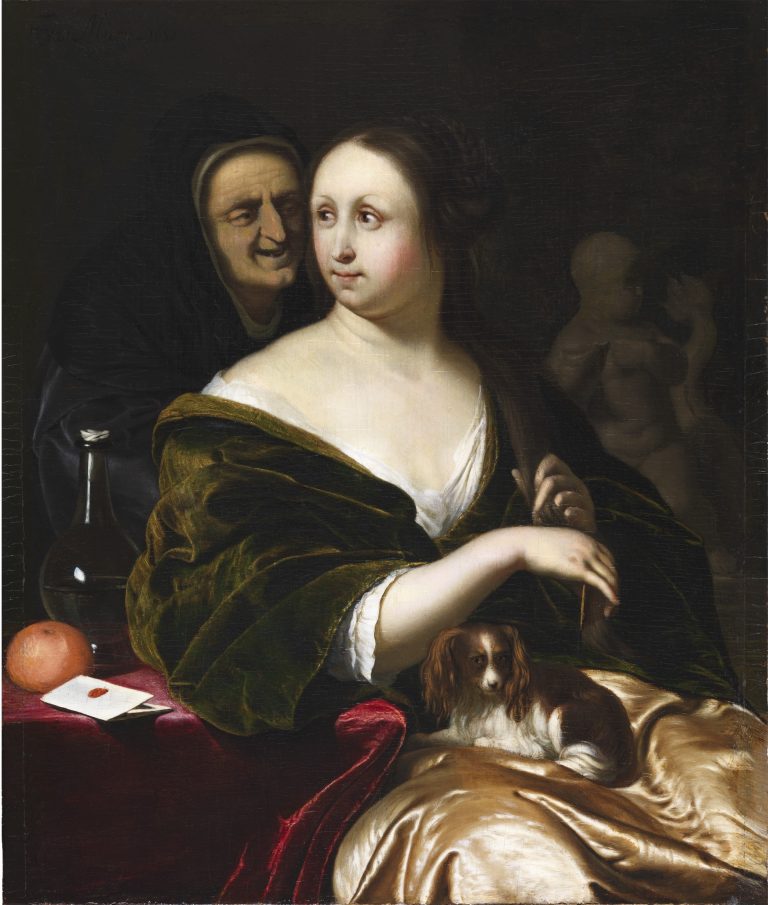Frans van Mieris painted this work in 1680, shortly before his death in March 1681. The painting exhibits all the features of Van Mieris’s late style, including the warm hues of its color scheme of browns and reds, the porcelain-like finish, and the shimmering highlights created with extremely fine yet fluid brushstrokes (see also FM-110). These effects allowed Van Mieris to unite his composition and impart grace and sophistication to his figures.1 The central focus is a young woman with a plunging décolletage who sits with a small spaniel on the lap of her shiny satin dress. Her white face contrasts with the dark and wrinkled visage of an old maidservant, who smilingly whispers in her ear.2 As the young woman listens, she gazes to the side with a slight smile and absentmindedly combs her long hair.3 The scene seems to be set after nightfall, making this one of Van Mieris’s few night scenes.4 That love is in the air can be deduced from the statue of a frolicking putto in the dimly lit background.5 On the table is an opened letter with a red seal, probably a love letter, an orange, and a glass bottle.
Van Mieris depicted many facets of the letter-writing and letter-receiving culture throughout the course of his career, including another painting from 1680, which shows a woman writing a letter while a boy waits for her to finish (fig 1).6 The genre character of that scene poses a striking contrast with the present painting, which belongs to a group of paintings in which letters feature in a more narrative context, such as The Matchmaker, 1671, in Dresden (fig 2).7 In The Matchmaker the word “AMOR” appears on a piece of furniture behind the woman. Dressed in contemporary attire, she holds a letter in her hand while sitting languidly, her left breast exposed. It is probable that she is Bathsheba, and the gesticulating old woman opposite her is the procuress or messenger sent by King David, whose wife Bathsheba would become.8 The Dresden painting was long considered to be a simple genre scene involving a love letter, and a similar misunderstanding also occurred with a painting of Bathsheba with King David’s Letter, ca. 1659–60, by Van Mieris’s good friend Jan Steen (1626–79).9
The present work also probably depicts the story of Bathsheba, given that Van Mieris typically located his biblical scenes in domestic settings (see FM-102). In this manner he was able to suggest the relevance of the biblical story to contemporary life. This approach also allowed him to shift the narrative emphasis from Bathsheba as the object of David’s sexual attraction to the moral dilemma Bathsheba faced as a married woman. Nevertheless, in this instance, her evocative gaze clearly foretells the path she will choose.
The Bible does not mention David writing to Bathsheba, but letters had become central to depictions of Bathsheba by the time Van Mieris painted this work, particularly among Leiden artists. The tradition may stem from a work by Jan Lievens (1607–74), which was extensively praised by Philips Angel (ca. 1618–45, or after), a Leiden painter, etcher and art theorist whose work Van Mieris surely knew. In his 1642 treatise, Lof der Schilder Konst, Angel wrote about the importance of the letter to this biblical story:
Without doubt such a messenger was an old woman well-versed in the art of love, or a procuress, so one calls her, who brought the message, not simply with her mouth alone, but undoubtedly through a letter (as evidence of a greater authority), which she handed to Bathsheba, wherin he [David] have [her] to undrstand his sweet consideration, which he had over [her] . . . thereby igniting a sweet blush of modest shame in her person, through the reading of the letter . . . such a hot fire of lust must have been in Bathsheba, whenever the king sought her.10
Not only does the old woman in Van Mieris’s painting descend directly from the procuress Philips Angel describes, but so does “the sweet blush of modest shame” on the face of the young woman who, imparting the significance of this most suggestive moment, gazes evocatively to the side, listening carefully to the words being whispered in her ear as the opened letter rests by her elbow.
